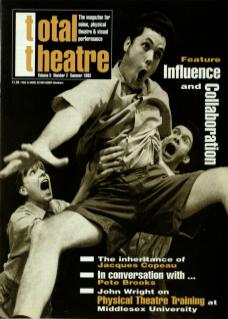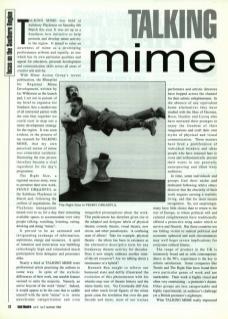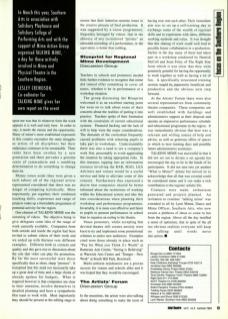Talking Mime was held at Salisbury Playhouse on Saturday 6 March this year. It was set up as a Southern Arts initiative to help promote and develop mime activity in the region. It aimed to raise an awareness of mime as a developing performance artform and, equally, as one which has its own particular qualities and appeal for education, personal development and communication skills across all areas of creative arts activity.
With Mime Action Group's recent publication, the Blueprint for Regional Mime Development, written by Jac Wilkinson, as the launchpad, I set out in pursuit of my brief to organise for Southern Arts a rendezvous of all interested parties with the aim that together we could start to map out a mime development strategy for the region. It was soon evident, in the process of my research for Talking Mime, that my own perceived notion of mime was somewhat outdated. Illustrating the true picture therefore became a vital ingredient for the day's programme.
The Right Size, a regional success story, were to premiere their new work, Penny Dreadful, at the Salisbury Playhouse in March and, following the swiftest of negotiations, the Playhouse management turned over to us, for a day, their remaining available spaces to accommodate over sixty people talking, watching, listening, eating, drinking and doing ‘mime’.
It proved to be an animated and invigorating exchange of information, aspirations, energy and resources. A spirit of intention and motivation was bubbling refreshingly high and stimulated much participation from delegates and presenters alike.
Nearly a third at Talking Mime were professional artists practising the artform in some way. In spite of the stylistic differences of their work, one notable feature seemed to unite the majority. Namely, an active boycott of the word ‘mime’. Indeed, it would appear to be the case that to saddle oneself with the term ‘mime’ is to invite unwelcome categorisation and even misguided presumptions about the work. This predicament has therefore given rise to the adopted and designer labels of physical theatre, comedy theatre, visual theatre, new circus, and other pseudonyms. A confusing state of affairs! Take for example, physical theatre – the idiom has been in existence as the alternative descriptive term for any breakaway theatre activity for decades. Does it now simply embrace another state-of-the-art crossover? Are we talking about a renaissance of a hybrid?
Kenneth Rea sought to relieve our bemused state and deftly illustrated the evolution of this phenomenon with his whistle-stop tour of theatre history and the mime family tree. Via Commedia dell'Arte and other much loved figures of the mime genre came the revelation that over the past decade and more, most of our trainee performers and artistic directors have hopped across the Channel for their artistic enlightenment. In the absence of any equivalent home alternatives they have studied with the likes of Decroux, Boso, Gaulier and Lecoq, who have nurtured their protégés to enjoy the freedom of their imaginations and craft their own styles of physical and visual communication. These masters have bred a proliferation of individual thinkers and ideas people who have returned here to roost and enthusiastically present their wares to our generally unsuspecting and often wary audiences.
In time, some individuals and groups find their niche and dedicated following whilst others discover that the obscurity of their work negates earning a realistic living. So, not surprisingly, many have little choice other than to return to the rest of Europe, to where political will and cultural enlightenment have traditionally offered a protective wing under which to survive and flourish. But these countries too are falling victim to radical political and economic upheaval and such circumstances may well beget severe implications for everyone’s cultural futures.
The range of product in the UK is immensely broad and as with contemporary dance in the 90s, experiment is the key to artistic satisfaction. Some companies like Trestle and The Right Size have found their own particular genre of work and are marketable. Their work is highly visual and often very entertaining – a promoter's dream. Other groups are less categorisable and highly experimental, an audience's challenge yet a British promoter's nightmare.
What Talking Mime really impressed upon me was that in whatever form the work appears it is well and truly here. In order to stay, it needs the means and the opportunity. Many of mime's more established exponents in this country encounter the same struggles as artists of all disciplines but their endurance continues to be remarkable. Their ranks have been swollen by a new generation and there pervades a genuine sense of camaraderie and a rumbling determination to do something to change their lot.
Money issues aside (they were given a tacit taboo), all of the regional artists represented considered that there was no danger of competing stylistically. More importantly, put together, their combined teaching skills, experience and range of projects make up a formidable programme of potential activity for the region.
One element of Talking Mime was the screening of videos, the objective being to give delegates some idea of the range of work currently available. Companies from both outside and inside the region had been invited to submit videos of their work and we ended up with thirteen very different examples. They were different both in content and quality, and this gave rise to discussion about the role that video can play for promotion. By far the most successful were those specifically shot as short, sharp ‘promos’. It transpired that this need not necessarily take up a great deal of time and a large chunk of already spoken for budgets. What is required however is that companies are clear in their intention, involve themselves in detailed planning, and have a sympathetic film team to work with. Most importantly they should be present at the editing stage to ensure that their intention remains intact in the creative process of final production. It was suggested by a venue programmer, frequently besieged by videos, that in the absence of any customised ‘promo’ an untreated recording of a performance, or the equivalent, is better than nothing.
Blueprint for Regional Mime Development Discussion Group
Teachers in schools and promoters needed little further evidence to recognise that mime did indeed offer something to cover all tastes, whether it be in performance or a workshop situation.
The group discussing the Blueprint welcomed it as an excellent starting point but went on to talk about some of their concerns about the realities of putting it into practice. Teachers spoke of their frustration with the constraints of current educational systems. Financial backing and the lack of will to help were the major considerations. The demands of the curriculum frequently caused problems with releasing pupils to take part in workshops. Understandably there was also a need to see a company's work first, presumably to avoid aggravating the situation by taking appropriate risks. In this instance, tapping into an information resource involving the RAB, MAG, LEA advisors and venues would be a useful service and help to alleviate some of this concern. Furthermore they expressed a desire that companies should be better informed about the restrictions of working within the Educational system and take this into consideration when planning their workshop and performance programmes. Invariably, it is more cost effective and fairer to pupils to present performances in school than to organise an outing to the theatre.
Venue promoters, whilst accepting that devised theatre still creates anxiety, were keen to try and implement some promotional schemes to entice new audiences. Examples cited were those already in place such as ‘Pay for What you think it's Worth’ at Battersea Arts Centre, ‘Seeing is Believing’ at Warwick Arts Centre, and ‘Danger – New Work’ at South Hill Park, Bracknell.
Multi-artform residencies are a proven success for venues and schools alike and it was hoped that they would be encouraged.
The Artists' Forum Discussion Group
In the meantime, the artists were also talking about doing something to make the most of having now met each other. Their immediate aim was to set up a self-training day to exchange some of the wealth of regional skills and to experiment with ideas, different working methods and styles. It was thought that this sharing of work could well lead to possible future collaboration in a production. Earlier in the day many of them had taken part in a workshop conducted by Hamish McColl and Sean Foley of The Right Size, from which it was clear that they were genuinely grateful for having the opportunity to work together as well as having a lot of fun. A specifically structured training session would be immensely beneficial and productive and the obvious next step forward.
At the Artists' Forum there were also several representatives from community theatre companies. These companies are well established with buildings and administrative support at their disposal and operate an impressive performance schedule and educational programme in the region. It was immediately obvious that here was a relevant and willing source of help and advice, as well as generous offers of spaces in which to host training days, and possible future administrative assistance.
Talking Mime was successful in that it did not set out to dictate a set agenda but encouraged the day to be in the hands of its participants. It did not turn into yet another ‘What is Mime?’ debate but moved on to acknowledge that all that was covered could be considered mime and it can make a rich contribution to the region’s artistic life.
Contacts were made. enthusiasm generated and projects planned. An invitation to continue ‘talking mime’ was extended to all by Lynn Maree, Dance and Mime Officer, Southern Arts, who now awaits a plethora of ideas to come to her from the region. Above all the day instilled a sense of optimism, that in spite of the all too obvious realities everyone will keep on talking until words move into action.


